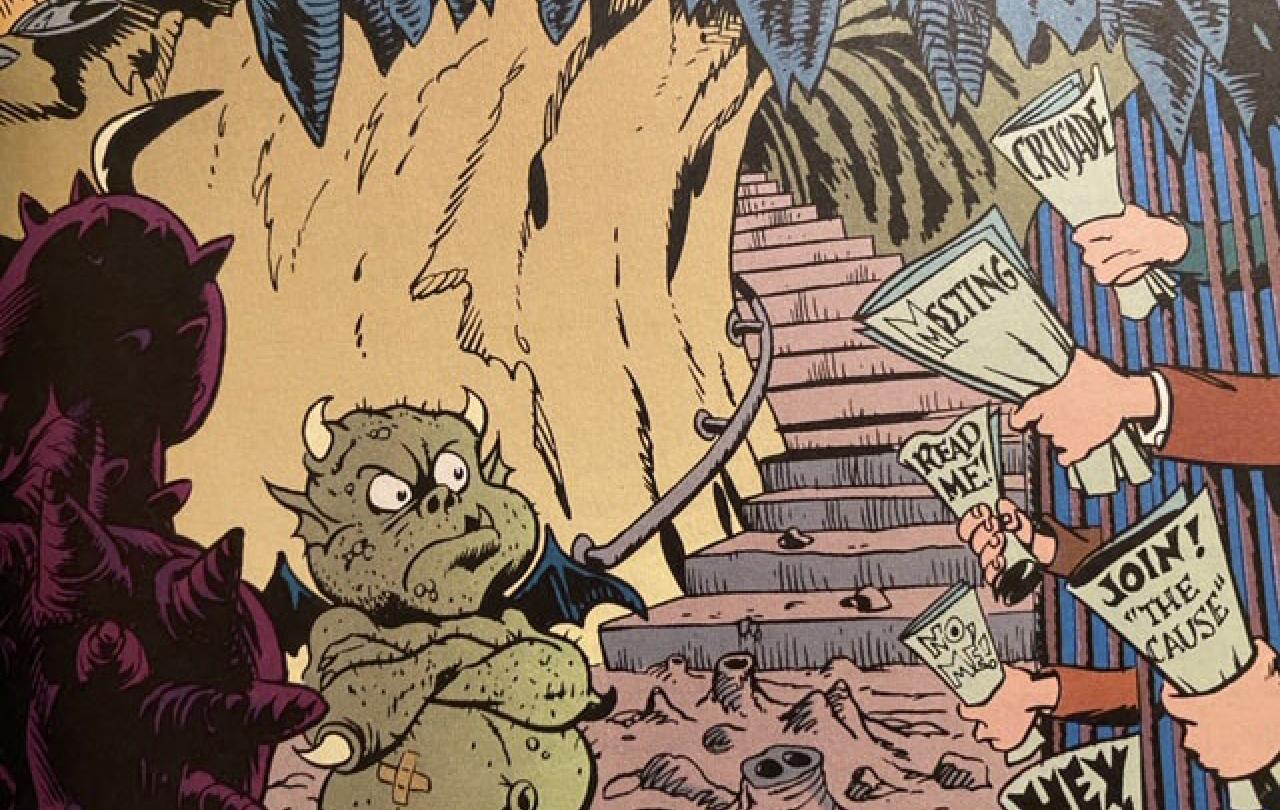
November 22nd is the sixtieth anniversary of the death of C.S. Lewis, an event that was overshadowed by the assassination of JFK on the same day. Although he is best known today as the author of the Narnia stories, the obituary that appeared in The Times newspaper a few days later noted that it was in fact The Screwtape Letters which sparked his success as a writer.
Initially published as a series of letters in the church newspaper The Guardian, The Screwtape Letters appeared in book form in 1942. The idea came to Lewis during an uninspiring sermon at Lewis’s local parish church in the Oxford suburb of Headington, in July 1940. Provisionally titled ‘As one Devil to Another’, the book would form a series of letters addressed to a novice devil, called Wormwood, beginning work on tempting his first patient, by an older, retired devil, called Screwtape. In finding Screwtape’s voice, Lewis was influenced by a speech given by Adolf Hitler at the Reichstag and broadcast by the BBC. What struck Lewis about the oration was how easy it was, while listening to the Führer speaking, to find oneself wavering just a little.
Lewis dedicated the volume to his friend and fellow Oxford academic, J.R.R. Tolkien. After Lewis’s death, having read an obituary in the Daily Telegraph claiming that Lewis was never fond of the book, Tolkien noted drily:
‘He dedicated it to me. I wondered why. Now I know.’
Despite Tolkien’s misgivings, the public devoured the work and it quickly became a bestseller. Although, as Lewis pointed out, numbers of sales can be misleading. A probationer nurse who had read the book told Lewis that she had chosen it from a list of set texts of which she had been told to read one in order to mention it at an interview. ‘And you chose Screwtape?’, said Lewis with some pride. ‘Well, of course’, she replied, ‘it was the shortest’.
Not all readers approved of its sentiments. A country clergyman wrote to the editor of The Guardian withdrawing his subscription on the grounds that much of the advice the letters offered seemed to him not only erroneous but positively diabolical. The confusion no doubt arose from the lack of any explanation surrounding their circumstances; in a later preface Lewis gave more context, though refused to explain how this devilish correspondence had come into his hands.
Its publication by Macmillan in 1943 brought Lewis to the attention of readers in the United States; when Time magazine featured an interview with him in September 1947, it carried the title ‘Don v. Devil’. A picture of Lewis featured on the magazine’s cover, with a comic image of Satan, complete with horns, elongated nose and chin, and clutching a pitchfork, standing on his shoulder.
For Lewis, the war did not present a radically different situation, but rather aggravated and clarified the human condition so that it could no longer be ignored.
The Screwtape Letters are the product of the war years, during which Lewis wrote many of his most popular works. It was in 1941 that he delivered the first of his broadcasts for the BBC Home Service, which launched his career as a public apologist for the Christian faith. In 1942 Lewis published Perelandra, the sequel to his first space travel novel Out of the Silent Planet (1938), in which his hero, Elwin Ransom, a Cambridge philologist – another nod to Tolkien – is summoned to Venus to prevent a second fall. Although it was published in 1950, The Lion, the Witch and the Wardrobe begins with four children being evacuated to the countryside to escape the London blitz. In setting his stories in outer-space or the fantastical world of Narnia, Lewis could be accused of writing escapist fiction that avoided the realities of a world in conflict. Lewis, however, believed that the war had not created a new crisis, but rather brought into clearer focus an ever-present struggle between good and evil.
For Lewis, the war did not present a radically different situation, but rather aggravated and clarified the human condition so that it could no longer be ignored. As he remarked in the second of his Broadcast Talks:
‘Enemy-occupied territory – that is what this world is. Christianity is the story of how the rightful king has landed, you might say landed in disguise, and is calling us all to take part in a great campaign of sabotage’.
The key point, writes Screwtape, is to fix the patient’s attention on ‘real life’ – but don’t let him question what he means by ‘real’.
Lewis’s message to a country living in fear of occupation by German troops was that the invasion had already happened. They had been summoned not to their country’s defence, but to its liberation. When the Pevensie children stumble into a snow-covered Narnia under the control of the tyrannical White Witch, they are told in hushed whispers of the rumours of Aslan’s return: ‘“They say Aslan is on the move—perhaps has already landed.”’ It is a reminder that Aslan enters Narnia as a rebel, intent on overthrowing the Witch and installing the rightful kings and queens on the thrones of Cair Paravel.
The Screwtape Letters do not ignore the war during which they were written; Wormwood’s patient is killed in the London bombing. But, for Screwtape, a war is of no value unless it results in winning souls for his Father Below. His advice to his nephew is concerned with diverting the patient from engaging with universal questions by distracting him with everyday preoccupations and sense experiences. While these might involve the immediate conflict, they could also be the excitement of a new romance, a falling out with a friend, the prospect of promotion, or an obsession with food. If the patient should begin to speculate about spiritual matters, Screwtape advises Wormwood to deflect him with academic theories and philosophies that avoid confronting the question of whether the Christian faith might actually be true. The key point, writes Screwtape, is to fix the patient’s attention on ‘real life’ – but don’t let him question what he means by ‘real’. It is ironic, Screwtape observes, that, while mortals typically picture devils putting ideas into their minds, their best work is done by keeping things out.
Despite numerous requests for sequels, Lewis was reluctant to twist his mind back into the ‘diabolical attitude’ and revisit the spiritual cramp it produced. Numerous spin-offs have appeared to fill the void, with Screwtape emails, audio and stage performances and even a Marvel comic book adaptation. Despite this, readers continue to turn to the original work. After all, Lewis’s depiction of hell as an unscrupulous business concern, whose employees are perpetually concerned about their own status, nursing grievances and resentment, speaks to our modern age just as much as it did to Lewis’s own.





